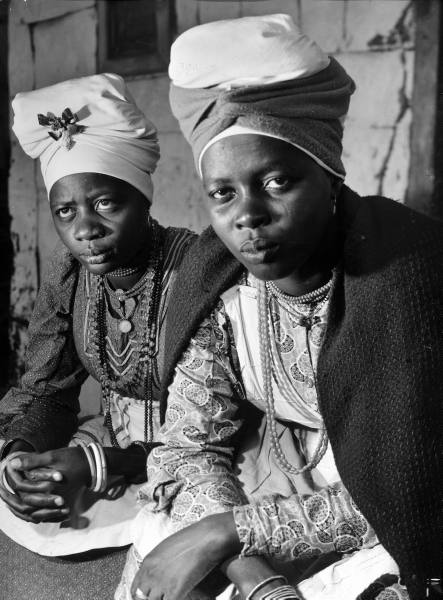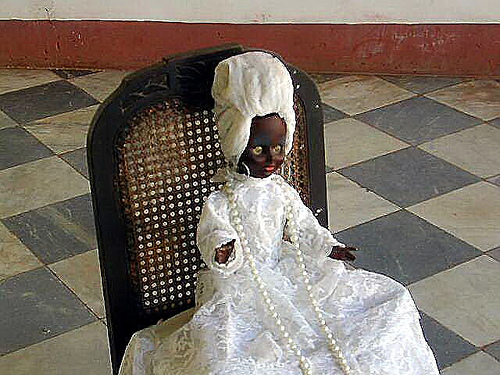How is a doll powerful? What aspects of humans are represented, which are excluded? How does segmenting a body affect the representation of a body? Cropping a body draws attention to certain body parts. How are these parts chosen? Do they vary with the function of the doll?
I have singled out certain important parts of the body, and the body as a whole, to examine. However, the sheer quantity and quality of detail in the Nkisi is far greater than in the normal Voodoo doll. Arms, legs, stomachs, and even belly buttons and toes are extensively carved and designed in Minkisi. For the Voodoo doll however, the form is far more anthropomorphic in terms of proportions and realism, but the detail is far lesser. There seems to be more of an 'artistic license' with the Minkisi, as they are a container for spirits, whereas the Voodoo doll can sometimes be tailored to represent an exact person. Therefore, due to their function, the representation of body parts is altered.
- Heads: "The dominance of head and shoulders in representation occurs ot such a degree that one assumes that this region of the body contains some essential truth of a person's being" (Bailey 2005).
Minkisi: The Nkubulu Nkisi, which could be used to detect witchcraft or cure headaches, often had a wild hairstyle. This, in accordance to Bailey's point, puts the focus on the bodily part of the Nkisi that it aims to affect in its subject. However, a sculptor's desire for recognition also comes into play, as unsual Minkisi are deemed more remarkable and attractive.
Voodoo doll: Almost all Voodoo dolls have a type of colourful turban on their heads. While this may in part be a practical choice (no need to add hair, sew with extreme care) it is also a cultural indication. Many women on the West coast of Africa (where many slaves originated from) have a culture of wearing wrapped cloth around their heads. The resemblance between the turban on the Voodoo doll and the one worn by these women is striking. Thus, the hat aims to anchor the doll in a particular cultural context. Different colours, textures and lengths can also help to identify the targeted person.
Proof:


- Faces: When a body is loosely designed, as the majority of Voodoo dolls' and Minkisi's are, the face becomes crucial in its importance. Even if the face does not represent a specific individual, a face makes the doll an identifiable individual. Facial characteristics, especially eyes, give the figurines a much more 'human' aspect. And when the face directly identifies someone, that Nkisi or doll becomes a clear miniature of a live human. This directly affects the way someone treats a doll, and probably brings out more powerful emotions regarding it. I believe this was demonstrated in class, when the face of a classmember was stuck on the head of the Sarkozy Voodoo doll. When the doll got back to me, Harrison Stark (the brave volunteer) did have multiple pins stuck in "him", including one in the middle of "his" forehead. However, he was unable to "self-poke", as were several other people in the class, indicating that a face is indeed one of the most powerful features of identification.
Minkisi: Often, a Nkisi is created without directly representing anyone. However, paint often covers its face, and the client who wishes to use the power of that Nkisi must in turn paint his or her face with the same colours. The face of a Nkisi is thus unchanging and fixed, and a human must adapt to it. In many ways, this gives humans a sense of being ephemeral while the Nkisi stays constant throughout the births and deaths of humans.
Voodoo doll: In Louisiana voodoo, some makers put a face on the doll, while others leave it blank for the user to do. This gives more power to the user, and removes the voodoo doll from its social context, allowing for more individual power as opposed to a societal power. In terms of the Voodoo doll, the face seems crucial. I, and many other willing pokers, had no problem stuffing needles into Sarkozy's body. However, if the face was not that of the French President, but of one's mother, father or loved one, how would that affect your interaction with the doll?
- Body shape:
Minkisi: Body posture is very contingent on the type of Nkisi concerned. The Nkondi, hunters, often have aggressive postures, such as a stuck out tongue or bared teeth. Many Nkondi also have their hands on their hips, in a defiant posture. However, the somewhat fragile materiality of the Minkisi is also a factor in its creation-- hands on hips are less likely to be cut off inadvertantly.
Voodoo doll: Usually, the shape is ill-defined, except at the waist. Many of the Voodoo dolls have string pulled taught at this area of the body, probably to emphasize body shape and feminity. The arms stick out, in an awkward scarecrow-like manner, perhaps to captivate the attention of the spirits and a potential client. It is also a very, open receptive position, signifying that the doll is open to posession. There is no real bodily shape; the clothes define the shape. Thus all the cloth is long and covers the body, the rope is what decides the places to be emphasized. Having a rope stuck around a doll, again, may be a practical thing but also sends back to issues of control and domination.
- Size: According to Bailey, when an object is made minature, it is better able to enter the personal sphere of the person handling it. When that object is a person, and thus the human body, this takes on a much larger meaning.
Minkisi: The most important and powerful Minkisi, especially the hunter Nkondi, were larger in size.
Voodoo doll: The Voodoo doll is much smaller than the average Nkisi.
- Gender representation:
Minkisi: The majority of Nkisi is male, although female forms also exist. Sexual organs are never represented in the Nkisi doll, but other clues symbolize the gender difference. Bears for instance, are often added to male figurines, while children are attached to female figurines, indicating that the Nkisi is both a woman and married. However, Minkisi are not strikingly gendered- perhaps because they belong so much to a higher, spiritual world. Though they are unquestionably human, it is hard to attribute an age, a race or sometimes even a gender to them.
Voodoo doll: Almost all Louisiana Voodoo dolls are female. This is predominantly because the majority of the spirits and deities invoked (excluding Legba) are women. The female sex is also the one majoritarily used in doll-making-- masculine dolls are called 'Action Men' or 'Power rangers.' The idea of a doll immediately-- and without being cognicent- invokes a woman to a person. Throughout history, women have mostly been associated with things such as spirits or witchcraft (Europe's witches, Salem etc.) Of course, this is a large claim to make, and I do not have the sources to substantiate it, but I will adventure to say that women are more strongly associated with spirits than men are.
- Absences:
Perhaps a missing facial detail leads the viewer to project certain emotions onto the doll, or invent an emotional state. The viewer draws conclusions, creates a replacement for the absence, and is thus further drawn into the world of the doll. In addition, it allows more freedom for choosing who is the subject of voodoo. A more general explanation could highlight the difference between dolls and humans. By already excluding certain body parts or features, the doll is immediately more available for further deconstructions and changes-- such as sticking a needle into it.
This is a fun analysis of the body of an Nkondi by the World Museum in Liverpool: http://www.diduknow.info/world/object2.html#image
Back to The voodoo doll
